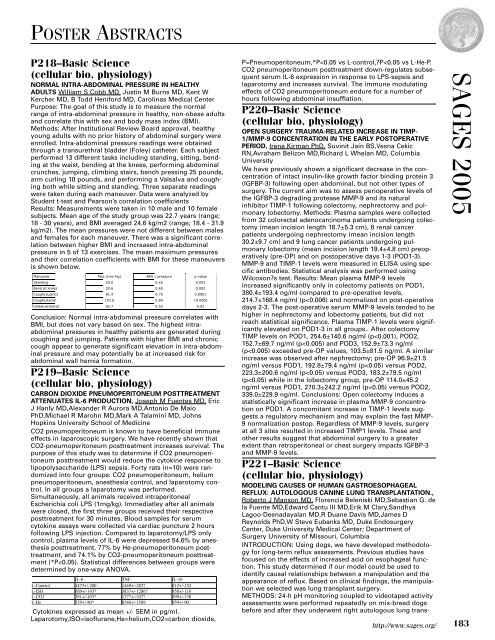2005 SAGES Abstracts
2005 SAGES Abstracts
2005 SAGES Abstracts
You also want an ePaper? Increase the reach of your titles
YUMPU automatically turns print PDFs into web optimized ePapers that Google loves.
POSTER ABSTRACTS<br />
P218–Basic Science<br />
(cellular bio, physiology)<br />
NORMAL INTRA-ABDOMINAL PRESSURE IN HEALTHY<br />
ADULTS William S Cobb MD, Justin M Burns MD, Kent W<br />
Kercher MD, B Todd Heniford MD, Carolinas Medical Center<br />
Purpose: The goal of this study is to measure the normal<br />
range of intra-abdominal pressure in healthy, non-obese adults<br />
and correlate this with sex and body mass index (BMI).<br />
Methods: After Institutional Review Board approval, healthy<br />
young adults with no prior history of abdominal surgery were<br />
enrolled. Intra-abdominal pressure readings were obtained<br />
through a transurethral bladder (Foley) catheter. Each subject<br />
performed 13 different tasks including standing, sitting, bending<br />
at the waist, bending at the knees, performing abdominal<br />
crunches, jumping, climbing stairs, bench pressing 25 pounds,<br />
arm curling 10 pounds, and performing a Valsalva and coughing<br />
both while sitting and standing. Three separate readings<br />
were taken during each maneuver. Data were analyzed by<br />
Student t-test and Pearson’s correlation coefficients<br />
Results: Measurements were taken in 10 male and 10 female<br />
subjects. Mean age of the study group was 22.7 years (range;<br />
18 - 30 years), and BMI averaged 24.6 kg/m2 (range; 18.4 - 31.9<br />
kg/m2). The mean pressures were not different between males<br />
and females for each maneuver. There was a significant correlation<br />
between higher BMI and increased intra-abdominal<br />
pressure in 5 of 13 exercises. The mean maximum pressures<br />
and their correlation coefficients with BMI for these maneuvers<br />
is shown below.<br />
Conclusion: Normal intra-abdominal pressure correlates with<br />
BMI, but does not vary based on sex. The highest intraabdominal<br />
pressures in healthy patients are generated during<br />
coughing and jumping. Patients with higher BMI and chronic<br />
cough appear to generate significant elevation in intra-abdominal<br />
pressure and may potentially be at increased risk for<br />
abdominal wall hernia formation.<br />
P219–Basic Science<br />
(cellular bio, physiology)<br />
CARBON DIOXIDE PNEUMOPERITONEUM POSTTREATMENT<br />
ATTENUATES IL-6 PRODUCTION, Joseph M Fuentes MD, Eric<br />
J Hanly MD,Alexander R Aurora MD,Antonio De Maio<br />
PhD,Michael R Marohn MD,Mark A Talamini MD, Johns<br />
Hopkins University School of Medicine<br />
CO2 pneumoperitoneum is known to have beneficial immune<br />
effects in laparoscopic surgery. We have recently shown that<br />
CO2-pneumoperitoneum posttreatment increases survival. The<br />
purpose of this study was to determine if CO2 pneumoperitoneum<br />
posttreatment would reduce the cytokine response to<br />
lipopolysaccharide (LPS) sepsis. Forty rats (n=10) were randomized<br />
into four groups: CO2 pneumoperitoneum, helium<br />
pneumoperitoneum, anesthesia control, and laparotomy control.<br />
In all groups a laparotomy was performed.<br />
Simultaneously, all animals received intraperitoneal<br />
Escherichia coli LPS (1mg/kg). Immediatley after all animals<br />
were closed, the first three groups received their respective<br />
posttreatment for 30 minutes. Blood samples for serum<br />
cytokine assays were collected via cardiac puncture 2 hours<br />
following LPS injection. Compared to laparotomy/LPS only<br />
control, plasma levels of IL-6 were depressed 54.6% by anesthesia<br />
posttreatment, 77% by He-pneumoperitoneum posttreatment,<br />
and 74.1% by CO2-pneumoperitoneum posttreatment<br />
(*P
















